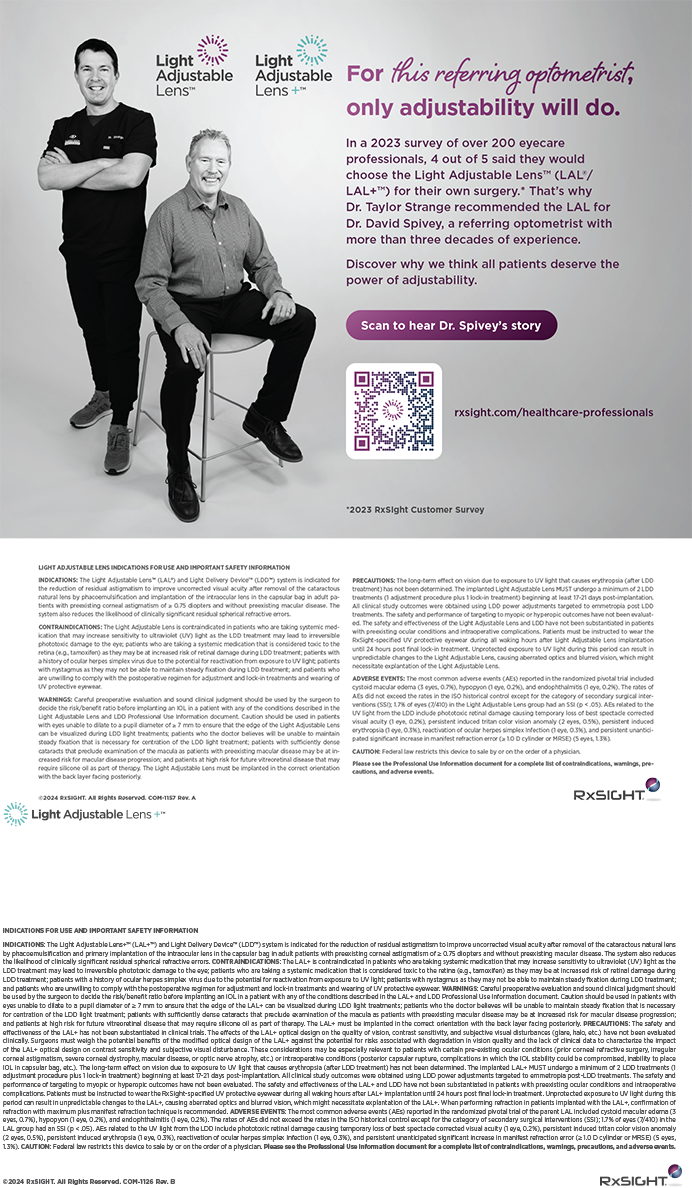

Immunohistochemical Study of Corneal Inflammation After Femtosecond Laser Clear Corneal Incisions or Manual Surgery
Toto L, Curcio C, Mastropasqua A, et al1
ABSTRACT
Following injury, corneal cells show a rapid response and release of cytokines, notably interleukin-18 (IL-18) and interferon-gamma (IFN-g), as well as upregulation of apoptosis that, in vitro, can be measured by terminal uridine deoxynucleotidyl transferase dUTP nick end-labeling (TUNEL) assay activity.1-3 The cytokine IFN-g is involved in a variety of immunomodulatory activities.1-3 IL-18 is secreted by corneal epithelial cells and may play a role in initiating inflammatory responses mediated by IFN-g.1 Keratocyte apoptosis has been noted to be the first observable stromal response after epithelial injury and is thought to be an initiating event in the wound-healing process.1-3
The use of a femtosecond laser in corneal refractive surgery has been associated with greater inflammation and apoptosis compared with manual procedures.1 In this experimental study, Toto and colleagues evaluated corneal inflammation (IL-18 and IFN-g levels) and apoptosis (TUNEL assay) induced after laser versus manually created clear corneal incisions (CCIs).
The analysis was conducted on 90 human cadaveric eyes deemed unsuitable for corneal transplantation. CCIs were performed manually with a 2.75-mm disposable keratome or with the LenSx Laser (Alcon) at different energies (3, 6, and 15 μJ, respectively). The corneas were then processed at 5 minutes and 4 hours after CCI. The investigators performed immunohistochemical staining to look for IL-18 and IFN-g, and they used an Apo-BrdU in situ DNA fragmentation assay kit to evaluate apoptotic activity (TUNEL assay).
The researchers found increased IL-18 expression in the laser groups versus the manual group 5 minutes after CCI. Additionally, IL-18 positivity increased with rising levels of laser energy. IFN-g positivity was significantly higher in laser groups using 6 and 15 μJ of energy, and it was higher in all laser groups compared with manual CCI. Apoptotic activity also increased significantly with higher laser energies and was significantly higher in all laser-treated corneas compared with those that received manual CCIs.
DISCUSSION
Multiple researchers have argued that laser cataract surgery has advantages over a manual approach.1-11 It has been suggested that the laser procedure offers superior incisional architecture and reduces intraoperative mechanical and thermal stress at the incision site.1,2,5 Additionally, greater CCI precision with the laser is associated with more predictable surgically induced astigmatism, which is especially important with premium IOLs.2 Other studies have shown laser CCIs to have better morphology, a lower percentage of postoperative endothelial and epithelial gaping, and less corneal edema at the incision site.2,3,5
Although Toto and colleagues demonstrated increased levels of inflammation and apoptotic activity with rising levels of laser energy, change in expression and localization of cytokines are important in corneal wound healing and homeostasis.1-3 Other researchers have found evidence of increased apoptotic activity with laser versus manual cataract surgery and have hypothesized that the difference was attributable to direct thermal-induced energy from the laser.1,5 Toto and colleagues suggested that using low energy settings could reduce inflammatory and apoptotic insults, theoretically promoting minimal tissue damage comparable to that occurring with the manual procedure.1 More research is necessary to elucidate the impact of increased inflammation on corneal wound healing after laser cataract surgery.
Neodymium:YAG Capsulotomy Rates Associated With Femtosecond Laser-Assisted Versus Manual Cataract Surgery
Tran D, Vargas V, Potvin R6
ABSTRACT
Posterior capsular opacification (PCO) is a common complication after cataract surgery that may reduce the efficacy of the implanted IOL. Standard treatment for PCO creates an opening in the posterior capsule with an Nd:YAG laser. Although this procedure is relatively simple and low risk, it entails additional visits and costs. Minimizing PCO and perhaps reducing the need for an Nd:YAG capsulotomy are therefore of interest.
AT A GLANCE
• An experimental study found greater corneal inflammation and apoptosis induced after laser versus manually created clear corneal incisions.
• In a single-center case study involving more than 1,500 eyes, Nd:YAG capsulotomy rates for posterior capsular opacification were significantly lower after laser versus conventional cataract surgery, but the time between surgery and capsulotomy was also significantly shorter for the laser group. In addition, patients with multifocal hydrophobic acrylic IOLs had a higher capsulotomy rate than those who received monofocal hydrophobic acrylic IOLs, independent of whether they underwent laser or manual cataract surgery.
• A case-controlled series matched 2,814 laser with 4,987 manual cases. The study was via the European Registry of Quality Outcomes for Cataract and Refractive Surgery. Manual cataract surgery appeared to produce slightly better outcomes in terms of visual acuity, safety, and postoperative complications.
IOL type, material, and design (sharp vs round edge) contribute to PCO formation.6-8 A well-centered capsulotomy with 360º overlap of the IOL’s optic ensures a “seal” between the posterior capsule and the posterior surface of the lens, potentially limiting the migration of lens epithelial cells (PCO precursors).6,7 In addition, IOL tilt (a consequence of an asymmetric capsulorhexis) may be associated with higher-grade PCO.6,7
Tran and colleagues sought to compare the Nd:YAG capsulotomy rates for PCO in manual versus laser cataract surgery.
This single-center case study identified more than 1,500 eyes that had undergone manual or laser cataract surgery, the latter performed with the LenSx Laser, over a 3-year period and that had a corrected distance visual acuity (CDVA) of 20/25 or better 1 to 3 months after surgery.6 The investigators noted the grade of PCO, IOL type and tilt, and capsulotomy complications.
Nd:YAG capsulotomy rates were significantly lower in the laser group (11.6% vs 15.2%), but the time between surgery and capsulotomy was also significantly shorter for these patients. The researchers suggested that the reduced duration was a function of the higher ratio of multifocal IOLs used in the laser versus manual group (6 times more common).
There was also a lower capsulotomy rate with hydrophobic acrylic IOLs compared with hydrophilic acrylic and silicone IOLs in the study. Upon further analysis, the investigators found that patients with multifocal hydrophobic acrylic IOLs had a higher capsulotomy rate than patients who received monofocal hydrophobic acrylic IOLs, independent of whether they underwent laser or manual cataract surgery (13% vs 8%).
Grade of PCO and CDVA before each capsulotomy showed no statistically significant difference between the two groups.6 There was a similar statistically significant improvement in CDVA after Nd:YAG capsulotomy in both groups.6
DISCUSSION
In this study, the rates of Nd:YAG capsulotomy were lower after laser versus manual cataract surgery. The investigators attributed the shorter period between laser cataract surgery and capsulotomy to the higher percentage of patients receiving a multifocal IOL. Other investigators have cited the relative intolerance of PCO formation among patients receiving multifocal lenses, because these implants can exacerbate any diminution in contrast sensitivity.6-8 In addition, IOLs made of a hydrophobic material were associated with higher capsulotomy rates than those composed of a hydrophilic acrylic material, a finding that is consistent with prior study results.6-8
This research by Tran and colleagues supports the use of a laser for creating a precise, consistent, centered capsulotomy, which appeared to reduce the severity and incidence of PCO formation compared with manual cataract surgery. It is postulated that better optic overlap of the capsular opening and increased lens epithelial cell death inhibit lens epithelial cell migration and thus decrease PCO formation.1-3,5-8 Better IOL centration and less tilt have been associated with laser cataract surgery and result in a decreased incidence of PCO.6,7
A precise capsulotomy and a lower rate of PCO formation may also have a positive economic impact for the health care system.6-8
Femtosecond Laser-Assisted Cataract Surgery Versus Standard Phacoemulsification Cataract Surgery: Study From the European Registry of Quality Outcomes for Cataract and Refractive Surgery
Manning S, Barry P, Henry Y, et al9
ABSTRACT
Femtosecond lasers execute the capsulotomy, lens fragmentation, CCIs, and astigmatic keratotomy in a precise, controlled manner. Although many studies have demonstrated the procedure’s strengths, no evidence to date shows that visual and refractive outcomes achieved with laser cataract surgery are significantly better compared with manual cataract extraction.
Manning and colleagues sought to delineate the differences between laser and conventional cataract surgery in a case-controlled series matching 2,814 laser with 4,987 manual cases. The study was arranged through the European Registry of Quality Outcomes for Cataract and Refractive Surgery, a well-established multinational cataract and refractive surgery database.
Ophthalmic surgeons from Europe and Australia participated (10 countries for experienced laser cataract surgeons and 19 countries for conventional cataract surgeons). For analysis, the investigators gathered demographic data as well as preoperative exam findings, target refraction, intraoperative data/complications/complications specific to the laser cataract procedure, and postoperative data.
The overall complication rate was higher in the laser group (2.9% vs 1.5%), but when events related to the laser procedure were excluded (eg, suction loss, incomplete capsulotomy), the laser patients actually had a lower complication rate (0.8% vs 1.5%). An improvement of 2.5 to 3 lines of CDVA was seen in 56.7% of laser and 66.1% of manual cataract patients, with laser patients gaining 3 logMAR letters more on average. Rates of vision-threatening postoperative complications such as corneal edema (0.5% vs 0.1%), early PCO (0.5% vs 0%), uveitis requiring treatment (0.5% vs 0%), uncontrolled IOP (0.2% vs 0%), and rupture of the posterior capsule (0.7% vs 0.4%) were low, but the laser group had statistically higher levels compared with the manual cataract group. In the study, 96.3% of laser cases had a CDVA of logMAR 0.3 or better compared with 97.1% of conventional cataract cases. The researchers reported that 72% of laser cases were within 0.50 D of their refractive target compared with 74.3% of manual cases; absolute biometry prediction error was 0.43 versus 0.40 D, respectively.
DISCUSSION
Several studies have touted the safety, efficacy, and precision of laser cataract surgery compared with conventional phacoemulsification.2,3,5-11 In this case-controlled study, however, manual cataract surgery appeared to produce slightly better outcomes in terms of visual acuity, safety, and postoperative complications. It is worth noting the limitations of this research: only 83% of laser cases were successfully matched to conventional phaco controls for age and preoperative CDVA, and multiple different laser platforms were used, which may have affected the results. In addition, the laser patients tended to be younger, have a higher rate of prior corneal refractive surgery, and have a more myopic postoperative target refraction, which could have influenced postoperative CDVA as well as refractive and biometric target results. The fact that these patients had slightly higher rates of postoperative complications compared with conventional phacoemulsification (higher IOP, uveitis incidence, corneal edema) may be related to proinflammatory effects of the laser; it has been shown that prostaglandin and certain inflammatory cytokine levels are higher in the aqueous after laser cataract surgery compared with manual phacoemulsification.1,5,9-11
Overall, the study by Manning and colleagues showed that postoperative and refractive results for laser cataract surgery are good and within the accepted standards for cataract surgery.9-11 Each ophthalmologist’s experience with laser cataract surgery and manual phacoemulsification is different, so physicians should counsel their patients accordingly. Further research, using a single laser platform and a randomized approach, would be needed to accurately compare the two techniques head to head.
1. Toto L, Curcio C, Mastropasqua A, et al. Immunohistochemical study of corneal inflammation after femtosecond laser clear corneal incisions or manual surgery. J Cataract Refract Surg. 2016;42(11):1649-1659.
2. Mastropasqua L, Toto L, Mastropasqua A, et al. Femtosecond laser versus manual clear corneal incision in cataract surgery. J Refract Surg. 2014;30(1):27-33.
3. Takacs A, Kovacs I, Mihaltz K, et al. Central corneal volume and endothelial cell count following femtosecond laser-assisted refractive cataract surgery compared to conventional phacoemulsification. J Refract Surg. 2012;28(6):387-391.
4. Alcon. LenSx Laser System Operator’s Manual. https://vision.beye.com/images/prod_img/doc_6471436810389.pdf. Issued February 2011. Accessed March 28, 2017.
5. Wolfgang JM, Klaproth OL, Hengere FH, et al. In vitro immunohistochemical and morphological observations of penetrating corneal incisions created by a femtosecond laser used for assisted intraocular lens surgery. J Cataract Refract Surg. 2014;40(4):632-638.
6. Tran D, Vargas V, Potvin R. Neodymium:YAG capsulotomy rates associated with femtosecond laser-assisted versus manual cataract surgery. J Cataract Refract Surg. 2016;41(10):1470-1476.
7. Kovacs I, Kranitz K, Sandor GL, et al. The effect of femtosecond laser capsulotomy on the development of posterior capsule opacification. J Refract Surg. 2014;30(3):154-158.
8. Elgohary MA, Beckingale AB. Effect of illumination on visual function after monofocal and multifocal intraocular lens implantation. Eye. 2006;20:144-149.
9. Manning S, Barry P, Henry Y, et al. Femtosecond laser-assisted cataract surgery versus standard phacoemulsification cataract surgery: study from the European Registry of Quality Outcomes for Cataract and Refractive Surgery. J Cataract Refract Surg. 2016;42(12):1779-1790.
10. Abell R, Darian-Smith E, Kan J, et al. Femtosecond laser-assisted cataract surgery versus standard phacoemulsification cataract surgery: outcomes and safety in more than 4000 cases at a single center. J Cataract Refract Surg. 2015;41:47-52.
11. Schultz T, Joachim SC, Kuehn M, et al. Changes in prostaglandin levels in patients undergoing femtosecond laser-assisted cataract surgery. J Refract Surg. 2013;29(11):742-747.




